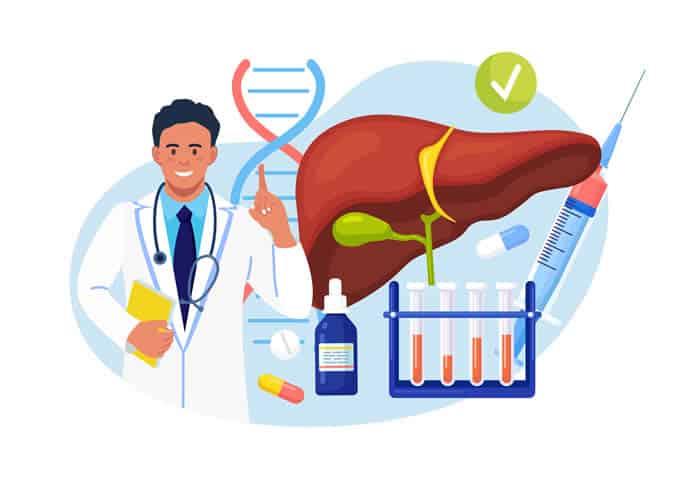
Previous
Connecting the Dots: Skin Rashes and Fatty Liver Disease

Next
Liver Detox Simplified: A Guide to Natural Liver Cleansing
New Liver Health Drugs for 2023 and Beyond
Find out about advances in liver health for 2023 and beyond, including potential drugs for NASH-related fibrosis and fatty liver.
Almost one in three Americans has liver disease in some form, though a large majority don’t even realize they have it. (1) Getting a proper diagnosis is key to also getting the necessary treatment to potentially keep this condition from progressing to liver cancer or liver failure. Like in many other areas of medicine, advances in liver health and liver disease treatments are happening all the time. Here’s what those advances look like in terms of available liver health drugs in 2023 and beyond.
Pegozafermin, Potential Liver Health Drug for NASH-Related Fibrosis
On June 26, 2023, the University of San Diego School of Medicine released the results of a study published in the New England Journal of Medicine just two days prior. (2) This study involved the use of a drug called pegozafermin which was identified as a potential new treatment for patients with fibrosis due to nonalcoholic steatohepatitis, more commonly known as NASH.
NASH is a disease in which the liver builds up fat. It is a type of nonalcoholic fatty liver disease (NAFLD) that is characterized by both liver inflammation and damage.
According to researchers, pegozafermin mimics a peptide hormone the liver naturally secretes: fibroblast growth factor 21 (FGF21). FGF21 regulates metabolic pathways involved in both health and disease. Though it is expressed in several bodily tissues, such as those found in the pancreas and brain, the liver is the main site responsible for this hormone’s production—which is also the same organ in which it tends to help decrease fat buildup. (3)
In the published study, 219 subjects received either the pegozafermin drug or a placebo. Those receiving the actual drug had greater improvements in liver fibrosis, which refers to the amount of scar tissue in this organ. Additionally, the higher the dosage of pegozafermin they received, the better the effects with 27% of the 44-milligram dosage group showing fibrosis improvement compared to 22% of the 15-milligram dosage group. (4)
The reason this is such a breakthrough is that there are currently no liver health drugs approved by the U.S. Food and Drug Administration (FDA) for treating NASH, which could make this the first of its kind.
Research to Begin on Semaglutide for NAFLD

NAFLD is also on the list of liver diseases with no FDA-approved drug-based treatments. But Jacobs Medical Center at UC San Diego Health is hoping to change this thanks to a $9.57 million grant that will be used to conduct a clinical trial to explore a drug called semaglutide as a potential fatty liver treatment option. (5)
Like pegozafermin, semaglutide mimics a hormone the body automatically makes—this one being the glucagon-like, peptide-1 hormone (GLP-1). This hormone is released in the gut after eating and, among several other functions, stimulates the release of insulin. (6)
Currently, the FDA has approved three prescription-based products containing semaglutide; however, none of these drugs are approved for the treatment of NAFLD. Instead, two are approved to treat type 2 diabetes (Ozempic and Rybelsus) and one is approved to treat obesity (Wegovy). (7)
If the results of this grant-assisted clinical trial are positive, it’s possible that the FDA’s approval for semaglutide in the treatment of NAFLD may be granted in the future.
Other Drugs Being Researched for Fatty Liver
Pegozafermin and semaglutide aren’t the only drugs that researchers are looking at to help treat fatty liver disease. Nonsteroidal farnesoid X receptor medications are also being investigated, one of which is cilofexor.
Cilofexor is currently being evaluated for treating NASH specifically. It appears to increase the production of fibroblast growth factor 19 (FGF19), which helps synthesize liver glycogen and reduce serum bile acids related to cholesterol. Individuals taking this drug also seem to tolerate it fairly well. (8)
Other researchers suggest that lipogenesis inhibitors might someday become “important agents” for managing NAFLD. (9) The reason for this assertion is that reductions in liver fat are very similar to reductions in de novo lipogenesis. So, if you lower lipogenesis, liver fat should lower too. Plus, these drugs appear to have good safety profiles.
With all of the research being conducted on liver health drugs, the hope is that someday—potentially in the not-too-distant future—medications for treating fatty liver diseases will exist. That will be a great day for individuals with these conditions which afflict a large part of the population.
(1) American Liver Foundation. (2023, September 11). How Many People Have Liver Disease? Retrieved November 17, 2023, from https://liverfoundation.org/about-your-liver/facts-about-liver-disease/how-many-people-have-liver-disease/
(2) UC San Diego Health. (2023, June 26). Study: Potential New Treatment Identified for Liver Disease. Retrieved November 17, 2023, from https://health.ucsd.edu/news/press-releases/2023-06-26-study-potential-new-treatment-identified-for-liver-disease/
(3) Tezze, C., Romanello, V., Sandri, M. (2019, April 17). FGF21 as Modulator of Metabolism in Health and Disease. Frontiers in Physiology. doi:10.3389/fphys.2019.00419
(4) Loomba, R., Sanyal, A., Kowdley, K., et al. (2023, June 24). Randomized, Controlled Trial of the FGF21 Analogue Pegozafermin in NASH. The New England Journal of Medicine. Retrieved November 17, 2023, from https://www.nejm.org/doi/full/10.1056/NEJMoa2304286
(5) UC San Diego Health. (2023, August 23). Clinical Trial Studying Possible New Treatment Option for Patients with NFLD. Retrieved November 17, 2023, from https://health.ucsd.edu/news/press-releases/2023-08-23-clinical-trial-studying-possible-new-treatment-option-for-patients-with-nafld/
(6) Müller, T., Finan, B., D’Alessio, D., et al. (2019, December). Glucagon-Like Peptide 1 (GLP-1). Molecular Metabolism. doi:10.1016/j.molmet.2019.09.010
(7) U.S. Food and Drug Administration. (2023, October 31). Medications Containing Semaglutide Marketed for Type 2 Diabetes or Weight Loss. Retrieved November 17, 2023, from https://www.fda.gov/drugs/postmarket-drug-safety-information-patients-and-providers/medications-containing-semaglutide-marketed-type-2-diabetes-or-weight-loss
(8) Younis, I., Kirby, B., Billin, A., et al. (2023, March). Pharmacokinetics, Pharmacodynamics, Safety and Tolerability of Cilofexor, a Novel Nonsteroidal Farnesoid X Receptor Agonist, in Healthy Volunteers. Clinical and Translational Science. doi:10.1111/cts.13469
(9) Esler, W., Cohen, D. (2023, November 15). Pharmacologic Inhibition of Lipogenesis for the Treatment of NAFLD. Journal of Hepatology. doi:10.1016/j.jhep.2023.10.042






